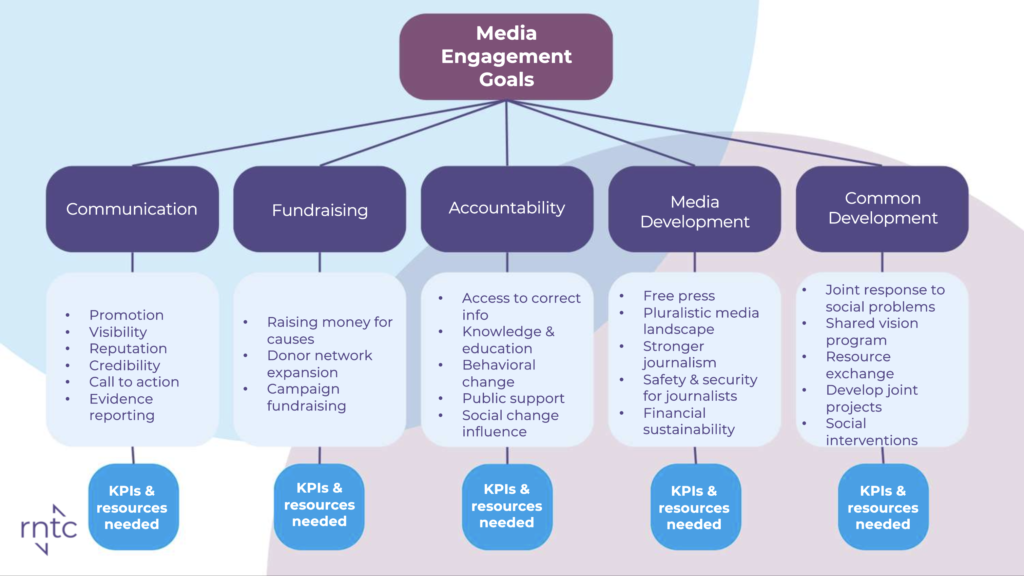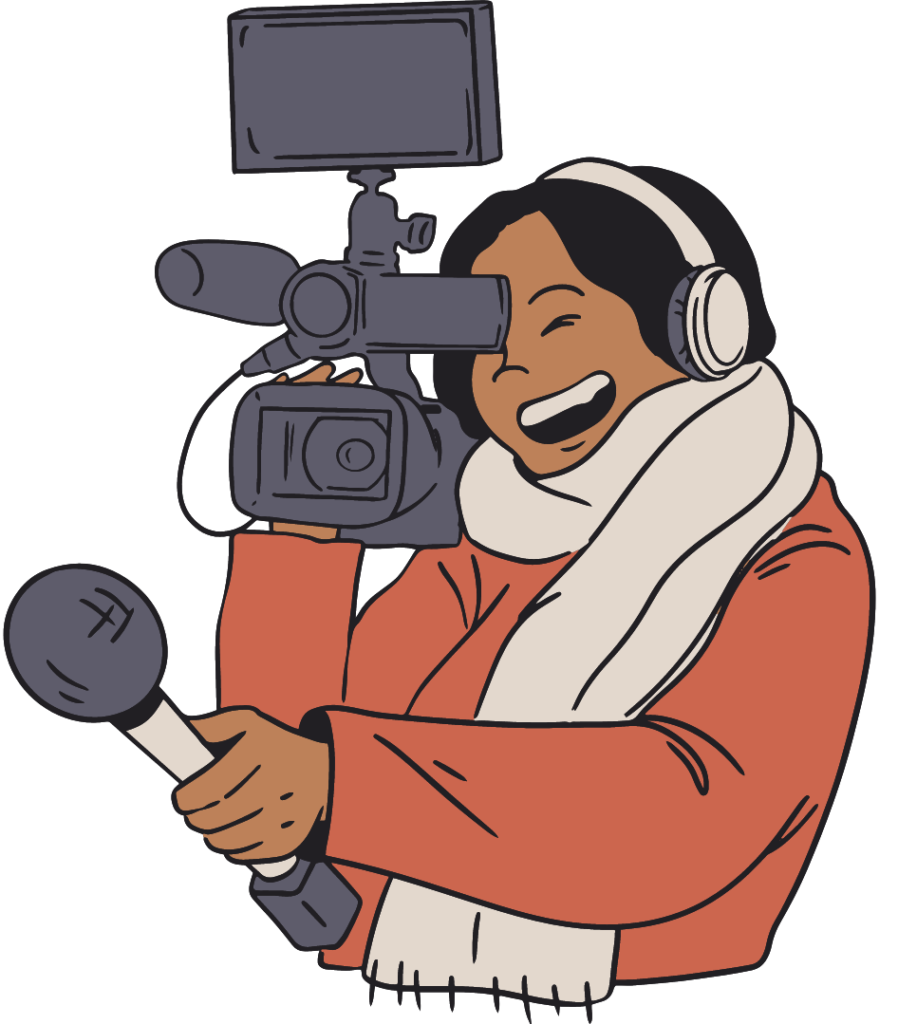Media Engagement Goals: 5 models for engagement that both sectors can use to collaborate with one another Copy Copy
As we have mentioned before, NGO&CSOs traditionally have engaged with media for the purpose of external communication, such as branding and building public relations. Usually, this approach for branding centers around efforts of channeling information to media via a press release, newsletter, contracting PR agencies, or inviting media to participate and report its on/offline activities. However, branding-oriented media engagement has become more problematic and less effective over the years. The branding approach is too focused on showcasing the organization’s vision without realizing that the content they use to do so might not be appealing to media organizations or their audiences. Besides, as we have exposed in the course, the potential for the development sector to collaborate with media organizations goes well beyond branding.
Thinking about the different opportunities, we have structured a list of possible engagement goals, or ways in which media/NGO&CSOs collaborations can direct their efforts. We categorize here five types of media engagement models based on the level of effectiveness and intensity of interactions and collaborations with media. Each one has specific intentions and different key performance indicators you can use to measure and monitor the impact of the desired goal. Please be aware that many times the collaboration might happen through a mixed model, the best route for the collaboration will depend on your desired impact and objectives.


MEG 1: Communication
One of the most common ways of why and how media is approached is to create visibility and to meet this goal. Our first Media Engagement Goal (MEG) is about working with media and social media for external communication, including branding, public relations, media relations, marketing, advertising, and networking. The purpose of doing so is to share information, tell stories, protect the brand’s reputation, and engage in conversations that inspire people to join their organizations in fulfilling their mission. Traditionally this model is falling under the mandates of the communication team.
Communication key performance indicators
KPI (Key Performance Indicators): a quantifiable measure of performance over time for a specific objective. The specific KIPs you will use depend on the specific reason you are choosing this MEG. For the case of communication, some examples of relevant KPIs can be:
- Active coverage.
- Potential reach.
- Share of voice.
- Social engagement.
- Sentiment.
- Media outreach.
- Quality of coverage.
- Geographical presence.
POP QUIZ!
- Who is the target audience of this video?
- How does Rainforest Alliance communicate its vision through this video?
- What kind of resources were required to make/produce this video?
- What KPIs could be used for measuring the impact of this video?

MEG 2: Fundraising
Another common goal in working with the media is our second model: fundraising. This includes establishing and growing the network of donors, developing fundraising campaigns and using social media as a tool to get individual donors.
Fundraising KPIs:
Some of the key performance indicators suitable for this goal are:
- Donor Growth (Year-Over-Year)
- Donation Growth
- Average Gift Size Growth
- Donor Retention Rate
- Pledge Fulfillment Percentage
- Social Media Engagement
- Fundraising ROI
POP QUIZ!
- Who is the target audience for this video?
- What creative strategies did they use to pursue their goal?
- What kind of resources were required to make/produce this video?
Extra resources: https://topnonprofits.com/9-key-fundraising-performance-indicators-every-nonprofit-should-be-tracking/

MEG 3: Accountability
Our third model has to do with Accountability. Media plays a role as an ally or gatekeeper to advance the implementation and delivery of certain SDGs via media engagement programming. Media engagement programming is a conceptual framework and methodological tool for programming, policies, and practices that integrate the inclusion and participation of media and social media. Access to correct information, knowledge & education, behavioural change, public support, and social change influence are some examples.
Accountability KPIs
Accountability refers to the willingness of people/organizations to take responsibility for their decisions, actions, behaviour, and performance. This means specific KPIs are needed depending on what areas we are hoping to be held accountable for. A good suggestion is that you define:
- Monitoring performance
- Interpreting performance
- Actions initiated
Together with RNW Media under the Masarouna project, 7amleh works to collect evidence on digital rights violations (including online BV) via https://7or.7amleh.org/ and then use the evidence to conduct advocacy meetings with meta, Twitter, and TikTok to push them to change their moderation policy.
Source for KPIs pathway: Measure Accountability

MEG 4: Media Development
The fourth model proposed here relates to the topic of media development. Media plays a role as a beneficiary to be supported and benefited from a more enabling environment for the growth of free and pluralistic media via media engagement programming. Some of the actionable results of this goal can be supporting freedom of expression and press freedom, strengthening independent and pluralistic media, strengthening journalistic skills, ensuring safety & security for media makers, and supporting media financial stability.
To understand this MEG, it is also important to define what we mean by “Media development”. As a unique multilateral forum in the UN system that mobilises the international community to support media in developing countries, the International Program for the Development of Communication (IPDC) of UNESCO looks at all aspects of the media environment and is structured around the five following categories:
- A system of regulation conducive to freedom of expression, pluralism, and diversity of the media
- Plurality and diversity of media, a level economic playing field and transparency of ownership
- Media as a platform for democratic discourse
- Professional capacity building and supporting institutions that underpins freedom of expression, pluralism, and diversity
- Infrastructural capacity is sufficient to support independent and pluralistic media
Media Development KPIs:
The metrics used to define the implementation of our MEGs are always in the process of reflection and adaptation. For freedom of speech, you could define KPIs in 5 areas: civic space , media , transparency , digital, and protection.
CASE STUDY – Free Press Unlimited “Free Press Unlimited is an international press freedom organisation that collaborates with 120 local media partners in 54 countries. With them, we work on our mission to make independent news and information available to everyone. Free Press Unlimited works on six themes to achieve her mission: making reliable information available to everyone. We are active all over the world, working together with many different (local) partners.” (FPU statement)
CASE STUDY – UNDP Media UNDP works closely with a range of media actors—whether newspapers and other print media, radio and TV networks or new media actors—to develop their capacities in support of inclusive governance, sustainable development, and peace. This work has included initiatives aimed at strengthening professionalism in the media sector, supporting the media’s ability to foster accountability and an informed citizenry (including through investigative reporting) and enhancing media actors’ capacities to report effectively on a range of urgent development issues. In Kenya, for instance, UNDP has helped journalists and social media actors better inform citizens on developments in the country’s extractives industry. In an effort to “leave no one behind”, UNDP Albania has been working for more than eight years with news outlets and journalists to combat discriminatory coverage of the country’s Roma and Egyptian communities. UNDP has also been piloting new initiatives to help media actors respond to rapidly transforming media ecosystems. In Sierra Leone, for instance, UNDP has helped promote digital media literacy among journalists and is exploring ways to support sustainable financial models for local media outlets—a key challenge for ensuring media pluralism and independence in the country.
Extra resources on the topic
- https://www.freepressunlimited.org/en/who-we-are
- https://www.article19.org/resources/new-article-19-metric-measures-global-threats-freedom-expression-information/
- https://www.article19.org/xpa-17/
- https://www.article19.org/resources/new-article-19-metric-measures-global-threats-freedom-expression-information/https://www.article19.org/xpa-17/

MEG 5: Common Development
Our fifth and final model is about common development, this means working with media and social media for mutually beneficial cooperation via a co-creation approach and joint programs. Media engagement for common development is a model of full-scale co-creation of products, services & programs, and projects for sustainable development between NGO&CSOs and media. This particular MEG refers to longer collaborative efforts (year-long programs) so in that sense, the KPIs will need to be divided into categories depending on the different goals set out by the proposal. Some of the ways this model can be manifested are:
- Responding to social problems via joined efforts
- Creating a shared vision
- Facilitate cross-organizational resource exchange
- Accelerating the development of projects
- Innovative and effective interventions
CASE STUDY – RHRN2 Right Here Right Now 2 (RHRN2) is a multi-year and multi-country program funded by the Dutch Ministry of Foreign Affairs which aims to empower young people in all their diversity to enjoy their sexual and reproductive health and rights in gender-just societies. One of the long-term objectives of the program theory of change (ToC) is to facilitate a critical mass that reinforces positive norms and values regarding young people’s sex, reproductive health and rights (SRHR) and gender justice. To achieve this objective, the RHRN2 coalition adopted a media engagement programming approach, in which media was identified as one of the most important influencers to be engaged and mobilized to change the socio-cultural norms and build more public support for young people’s SRHR. RHRN2’s approaches targeting media include media actors mapping, media engagement strategy development, sharing stories with media, identifying and tracking harmful media discourse, building the capacity of media professionals on inclusive and gender-sensitive reporting, joint campaigning and advocacy, media fellowships etc.
The basis for the Media Engagement Strategy
It’s important to mention that often the five models we identified for different types of media engagement are overlapping or are mixed in practice. There is no right or wrong when it comes to deciding which models you choose; the selection will be based on your vision and mission, and what resources are available.
After you choose the right media engagement models for your organization, you need to define clear objectives on how to achieve those goals and develop a measurement and evaluation framework to monitor the progress. You can define multiple objectives working with the media but remember that your objectives must be SMART (specific, measurable, achievable, realistic or relevant, and time-bound).
Theory of Change & Target Audience
The right media engagement strategy will be defined firstly by your organization’s vision/mission. In other trainings, we have explained how to decide the correct Theory of Change (ToC) and define your Target Audience & Final Beneficiaries. For this training, it’s important to have this defined beforehand to have a consistent strategy for media engagement. We will not cover this in this course but let’s have a quick recap about what ToC and TA mean:
- A Theory of Change (ToC) is a methodology that comprehensively describes why and how the desired (social) change you want to contribute to is expected to happen.
- The Target Audience is the group(s) of people a program is designed to serve. For a program to remain focused and to deliver effective services, it must clearly define its TA and establish a referral mechanism that will ensure it receives the appropriate cases.
Key takeaways
We propose 5 models for media engagement goals you can follow to start your strategy!
- MEG 1: Communication
- MEG 2: Fundraising
- MEG 3: Accountability
- MEG 4: Media Development
- MEG 5: Common Development
